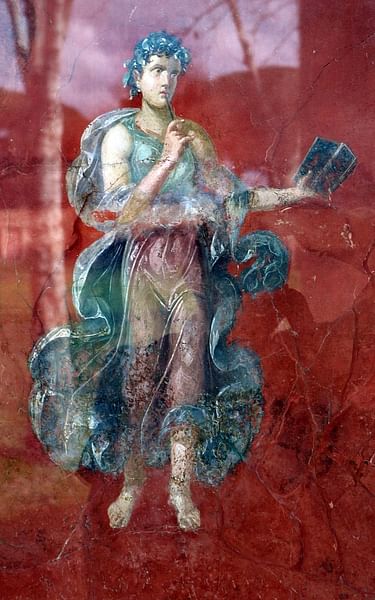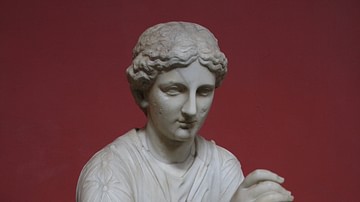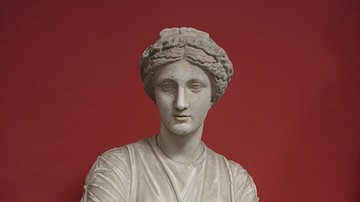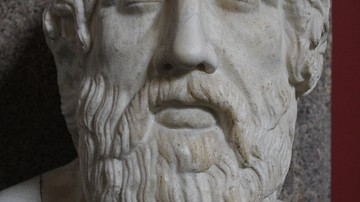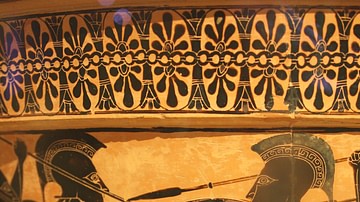
Calliope (also spelt Kalliope) is the Muse of epic poetry and heroic song in Greek mythology. She is considered the leader of the Muses and the most honoured of them all. She is often represented in art with a tablet on her knee and a stylus in her hand.
Homer (c. 750 BCE) was said to be directly inspired by Calliope to write the Iliad and the Odyssey, two of the most famous epic poems of all time. His great talent for epic poetry meant that he was also referred to as Calliope's son (in a symbolic sense).
Birth & Family
Calliope is the daughter of Zeus and Mnemosyne (goddess of memory). She is one of the nine canonical Muses, with the others being Clio (history), Euterpe (flute-playing), Thalia (comedy), Melpomene (tragedy), Terpsichore (dancing), Erato (lyric and love poetry), Polyhymnia (sacred song) and Urania (astronomy). According to Hesiod (c. 700 BCE), Calliope is the most important Muse.
So sang the Muses of Olympus, nine
Daughters begotten by almighty Zeus,
Cleio, Euterpe, and Melpomene,
Thalia, Erato and Terpsichore,
Polymnia, Urania, and most
Important one of all, Calliope,
For she attends upon respected lords.
(Hesiod, Theogony, 77-83)
The Muses
The Muses were the patron goddesses of literature and the arts and inspired all artistic activity in the ancient world. They held a distinguished position in Greek mythology and were honoured by both mortals and immortals alike. Apollo, the Greek god of music and dance and a patron of the arts, was a leader of the Muses.
Over time, each of the nine Muses came to represent a specific art form. As a group, they were called the Heliconiades and the Olympiades in reference to the various places they frequented, including Mount Olympus and Mount Helicon in Boeotia.
According to Homer, the Muses lived on Mount Olympus, where they entertained the Olympian gods with their singing and inspired the poets. On Mount Helicon, they were said to dance around the sacred fountain of Hippocrene and the altar of Zeus.
Calliope as the Muse of Epic Poetry
Calliope ('beautiful voiced') was widely considered the leader of the Muses and was the greatest and wisest of them. She began as a Muse of poetry, which later developed into epic poetry (tales of the legendary adventures of a people, its myth, and heroes). As a Muse of epic poetry, she inspired the great epic poets throughout history, including Homer, Virgil (70-19 BCE), Ovid (43 BCE to 17 CE) and Dante Alighieri (1265-1321 CE). She also determined the standards by which epic poetry was judged and was regularly called on for help when poets were writing their work.
Calliope was often represented in art as a seated or standing figure, holding a writing tablet and a stylus, as if she were getting ready to write the next great epic poem.
Calliope's Children
Calliope was the mother of Orpheus, the most famed musician in all of Greek mythology. He was said to have received his gift of music from his father, Apollo. However, in some traditions, his father is listed as the mortal King Oeagrus of Thrace. In Ovid's Metamorphoses, Orpheus calls to his mother in song: "Let Jove be the start of my song, Callíope – Muse and mother!" (Ovid, Metamorphoses, 10.148)
Calliope and Apollo, or King Oeagrus, were also said to be the parents of Linus, another great musician in Greek mythology and an eloquent public speaker. Some sources state that Calliope is also the mother of Rhesus, a king of Thrace, with the river god Strymon, and that she bore the Korybantes (worshippers of Cybele) with her father, Zeus.
Calliope as Judge
In some traditions, Calliope was the mediator for a conflict that took place between Adonis, Aphrodite and Persephone. Adonis was born out of a tree after his mother, Smyrna, tricked her father into an incestuous relationship (helped by the influence of Aphrodite) and fell pregnant. To escape her father's wrath, the gods transformed her into a myrrh tree, and the tree split open ten months later to reveal Adonis.
Adonis' beauty was legendary and did not escape the attention of Aphrodite, who stole him and hid him away in a chest that she entrusted to Persephone. Persephone opened the box and witnessed Adonis' beauty for herself, refusing to give the box back to Aphrodite.
Zeus employed the help of Calliope to judge who would get to keep Adonis. Calliope decided that Aphrodite and Persephone would spend equal parts of the year with Adonis, with Aphrodite in the celestial realm and Persephone in the underworld. Furious with this decision, Aphrodite causes the death of Calliope's son Orpheus by inciting the Thracian women to attack him while they were in a trance. In their frenzy, they end up tearing Orpheus limb from limb.
Challenging the Muses
Like all Greek deities, the Muses can become competitive when their artistic talents and powers are challenged. This combativeness can best be seen in the myth of Thamyris. Thamyris was a bard from Thrace who met the Muses on his travels. He foolishly boasted to them that he could outperform them at singing. In anger, the Muses struck him blind, took away his musical ability and made him forget he could sing.
Another example is the tale of the Pierides. The Pierides, nine daughters of the wealthy landowner Pierus (sometimes confused with the Muses), also claimed that they could outsing the Muses. In Ovid's Metamorphoses, the Muse Urania tells Minerva of the competition. She claims that the Pierides offered the Muses their home in Emathia's plains if they were victorious. But if the Muses lost, then they would have to gift the Pierides their two sacred Boeotian fountains. The nymphs were selected as judges and swore to judge fairly. Calliope was chosen to sing on behalf of the Muses.
She, with her flowing hair in an ivy wreath, rose up and strummed a few plangent chords to test her lyre strings,
then firmly plucked them to launch at once on the
following lay.
(Ovid, Metamorphoses, 5.338-340).
Calliope invoked the goddess Ceres and then sang about the rape of Proserpina (Persephone) in three parts. The first part told the tale of how Pluto's rape and abduction of Proserpina caused Ceres to neglect the earth for half of the year. The river nymph Arethusa relayed that she had seen Proserpina, still sad and scared but well-established as the queen of the underworld. Ceres travelled to the realms of the sky, where she pleaded for her daughter's return. Jupiter settled the conflict by splitting the year into two equal parts where she could spend half the year with her mother and the other half with her husband.
The song's second half recounted how Arethusa was almost raped by the river god Alpheüs and fled her birthplace, offering some insight into Proserpina's ordeal. The last part of the song tells how Ceres gave Triptólemus (king of Eleusis) seeds to sow. He landed on Scythian land and entered the palace of King Lyncus, who he ordered to plant the seeds from Ceres. The king, wanting to take credit for the seeds himself, waited for Triptólemus to fall asleep and attempted to attack him before Ceres turned him into a lynx.
The nymphs ruled in the Muses' favour and the Pierides, angered by their loss, started abusing the Muses. As they continued their shouting and brandishing of fists, they noticed feathers sprouting on their skin and beaks protruding from their faces. Finally, they took to the sky, and to this day, you can still hear them chattering away.
According to Pausanias (c. 115 to c. 180 CE), the Sirens also challenged the Muses to a singing competition after being persuaded by Hera to do so. But, as always, the Muses could not be beaten, and they crowned themselves as the victors with the Sirens' feathers.
Worship & Legacy
Pierus, the king of Emathia (in Macedonia), is believed to have offered the first sacrifices to the Muses and helped their worship spread from Thrace to Thespiae, located at the foot of Mount Helicon, where they had a temple and statues. Near Mount Helicon, there was a sanctuary with sculptures and sacred wells dedicated to them. On Mount Libethrion, there was a holy grotto of the Muses. The Thespians celebrated a "feast of the Muses" (Musea) on Mount Helicon, where libations of milk, honey and water were offered to them.
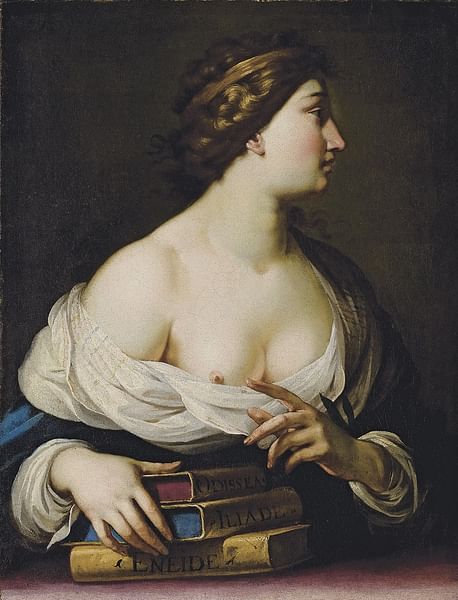
Calliope's influence on poets and writers was still evident during the Middle Ages, with Italian poet Dante Alighieri invoking her in his Divine Comedy in both the second canto of Hell (Inferno) and in the first Canto of Purgatory (Purgatorio). In addition, English poet Geoffrey Chaucer (c. 1343-1400) mentions her in his poem House of Fame (the only Muse to be mentioned by name). She is also invoked in Chaucer's epic poem Troilus and Criseyde, where he calls for the help of Calliope and Venus in the opening lines of Book 3 to help him describe the great joy that Troilus and Criseyde felt when they finally became lovers.
More recently, a steam piano called Calliope was patented in 1855 by J.C. Stoddard. It became a fixture on riverboats, showboats, and circuses during the late 1800s. In 2020, famed rocker Bob Dylan released a song called "Mother of Muses," where he proclaimed, "I'm falling in love with Calliope." (Bob Dylan, "Mother of Muses"). In honour of the famed Muse, the smallest hummingbird in the United States is called the Calliope hummingbird.


